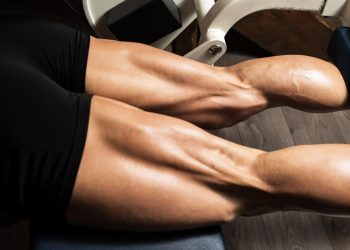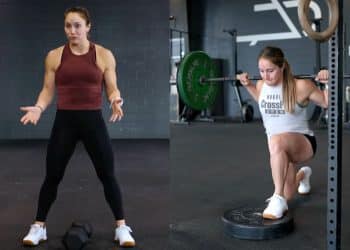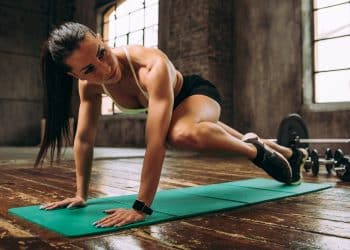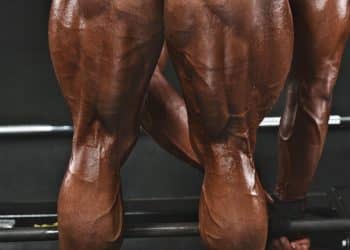If you train in a gym, you’ve got plenty of hamstring training options to choose from. Most gyms have at least a few different leg curl machines, and you can also do Romanian deadlifts, good mornings, and cable leg curls.
Hamstring workouts need never be boring!
But, if you train at home or prefer bodyweight workouts, you may be struggling for ways to hit your hammies. That’s not to say you don’t have options; it’s just that your choices aren’t so obvious.
The good news is that there are actually plenty of bodyweight exercises for the hamstrings, and one of the best is the hamstring walkout.
In this article, we reveal why and how to do this exercise and provide you with eight equally effective variations and alternatives.
Hamstring Walkouts – Muscles Worked
It’s probably no surprise to learn that hamstring walkouts train your hamstrings! However, they do involve a couple of additional muscles, too:
Level Up Your Fitness: Join our 💪 strong community in Fitness Volt Newsletter. Get daily inspiration, expert-backed workouts, nutrition tips, the latest in strength sports, and the support you need to reach your goals. Subscribe for free!
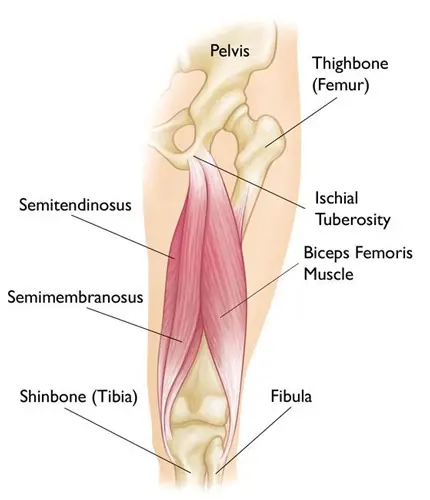
Hamstrings
The hamstrings are actually a group of three muscles: the biceps femoris, semimembranosus, and semitendinosus. These muscles work together to flex your knees and extend your hips. Hamstring walkouts are one of several exercises that combine both of these functions.
Gluteus maximus
The Gluteus maximus, or glute max for short, is the largest muscle in the human body and potentially the strongest, too. Located on the back of your hips, you are probably sitting on your glute max right now! The primary function of the gluteus maximus is the extension of the hip. Still, different fibers of the glutes also play a part in hip abduction, hip adduction, and external rotation.
Abductors
The abductors lift your leg out and away from the midline of the body. During hamstring walkouts, your abductors primarily work as stabilizers, preventing your knees from caving in. The three main abductors are gluteus minimus, gluteus medius, and tensor fascia latae, which are located on the outside of your hip and thigh, respectively.
Adductors
Located on the inside of your thighs, the adductors draw your legs in and toward the midline of your body. The adductors are longus, brevis, and magnus, meaning longest, shortest, and biggest. Like the abductors, the adductors work mainly as stabilizers during hamstring walkouts and stop your knees from falling outward.
Core
Core is the collective term for the muscles that encircle your midsection. These muscles work a lot like a weightlifting belt to support and stabilize your lumber spine. The main core muscles are the rectus abdominis, obliques, and transverse abdominis. The Erector spinae, a lower back muscle, is also involved in hamstring walkouts.
How to Do Hamstring Walkouts
Get more from hamstring walkouts while keeping your risk of injury to a minimum by following these guidelines:
- Lie on your back with your legs bent and arms by your sides. Brace your core.
- Pull your toes up and press your heels into the floor. Contract your glutes and hamstrings and lift your hips up toward the ceiling.
- Maintaining core tension, take small steps and walk your feet out until your legs are almost straight. Do not allow your butt to touch the floor.
- Walk your feet back in, and then repeat.
Tips:
- Take small steps to keep maximal tension on your hamstrings and glutes.
- Put a booty band around your knees to increase glute activation.
- Try to avoid pressing down with your arms, as doing so takes work away from the target muscles.
- Wear shoes or do this exercise on a mat for comfort and to avoid slipping.
- Take care not to hyperextend your lower back during this exercise. Instead, lift your hips, but don’t push them up so far you arch your lumbar spine.
Hamstring Walkouts: Benefits and Drawbacks
Not sure if hamstring walkouts deserve a place in your leg workouts? Consider these benefits and then decide!
Anywhere, anytime
You don’t need any equipment to do hamstring walkouts. In fact, even a mat is optional! As such, you can do this exercise anywhere you’ve got the space to lie down, such as at home, in a hotel room, or even in a jail cell. They’re the perfect excuse-free glute and hamstring exercise.
The perfect partner for bodyweight squats, lunges, etc.
Bodyweight squats and lunges are excellent lower-body conditioning exercises, especially when performed for medium to high reps. Try doing 50-100 air-squats or five minutes of non-stop walking lunges to appreciate how effective these exercises can be.
However, bodyweight squats and lunges are also very quads-centric, and while your glutes and hammies are involved, they’re not working particularly hard.
Hamstring walkouts are the perfect complementary exercise as they provide your hamstrings and glutes with a great bodyweight workout. Do hamstring walkouts to ensure your hamstrings and glutes are as well-developed as your quads.
Very lower-back friendly
Unlike many hamstring exercises, hamstring walkouts put very little stress on your lower back. Done correctly, you should not feel your lower back working at all. This is good news for anyone who suffers from lower back pain.
While hamstring walkouts are a mostly safe and beneficial exercise, there are also a couple of drawbacks to consider:
Limited overload
The stress on your muscles comes only from your body weight, so this exercise is not particularly demanding unless you go very slowly or do a lot of reps. You can also make it more challenging by contracting your muscles as hard as possible.
Even then, some people may find this exercise does not present much of a challenge or that they quickly get used to it.
Not a good hypertrophy exercise
While you can use hamstring walkouts to strengthen your hamstrings and improve muscle tone and endurance, you probably won’t build bigger, more muscular hammies. The load is not really heavy enough, and you’ll get better results from exercises like Nordic curls, Romanian deadlifts, and leg curls.
8 Hamstring Walkout Variations and Alternatives
Hamstring walkouts are a highly effective posterior chain exercise, but that doesn’t mean you need to do them all the time. There are several variations and alternatives you can use to keep your workouts productive and interesting:
1. Elevated hamstring walkouts
The elevated hamstring walkout saves you from having to lie on the floor, so it’s potentially a more comfortable exercise. It also provides a bit more distance between your butt and the deck, so you won’t have to worry so much about keeping your hips up. It feels a little different, too, and when it comes to avoiding training plateaus, different is good!
Steps:
- Lie with your upper back and shoulders crossways on an exercise bench. Lift your hips and bend your knees so your body is parallel to the floor and your knees are flexed to 90 degrees. Tense your core and glutes.
- Next, take small steps and walk your feet forward until your legs are straight and your weight rests on your heels. Keep your hips up.
- Walk your feet back un until they’re directly beneath your knees, and repeat.
Muscles Targeted:
- Primary: Hamstrings, gluteus maximus.
- Secondary: Core.
Benefits:
- More comfortable than the floor version.
- You don’t have to extend your hips as much, so it’s even easier on your lower back.
- A different angle and body position, so a good way to add some variety to your workouts.
Tips:
- Use a booty band to increase glute and hip abductor activation.
- Drive your heels down and back to maximize glute engagement.
- You can also do this exercise with your upper back resting on a stability ball.
2. Stability ball hamstring rollout
Why walk when you can roll?! Stability ball hamstring rollouts are very similar to walkouts, but the movement is smoother and more like a leg curl. So, if you’ve got a stability ball, you may prefer this exercise for hitting your hammies. It also produces an intense mid-rep contraction, so you’ll really feel this exercise working.
Level Up Your Fitness: Join our 💪 strong community in Fitness Volt Newsletter. Get daily inspiration, expert-backed workouts, nutrition tips, the latest in strength sports, and the support you need to reach your goals. Subscribe for free!
Steps:
- Lie on your back and rest your feet on a stability ball. Place your arms on the floor by your sides for balance. Lift your hips up, so your legs and body are straight.
- Bend your knees, drive your hips upward, and roll the ball toward you. Pause at the top of each rep for 2-3 seconds.
- Extend your legs, lower your hips, and repeat.
Muscles Targeted:
- Primary: Hamstrings, gluteus maximus.
- Secondary: Core, calves.
Benefits:
- A good alternative to hamstring walkouts.
- An accessible but effective bodyweight hamstring exercise.
- Very lower back friendly.
Tips:
- Lower your hips to the floor between reps or keep them up as preferred.
- Make this exercise harder by using one leg at a time.
- You can also do this exercise with a suspension trainer, such as a TRX, like this:
3. Glute bridge V walkout
The glute bridge V walkout, also known as the straddle walkout, is a more butt-centric version of the hamstring walkout. Taking your legs out wide means you’ll have to engage your glutes and abductors more, making this a more challenging exercise.
Steps:
- Lie on your back with your legs bent and arms by your sides. Brace your core.
- Pull your toes up and press your heels into the floor. Contract your glutes and hamstrings and lift your hips up toward the ceiling.
- Maintaining core tension, take small steps and walk your feet apart and away until your legs are almost straight. Do not allow your butt to touch the floor.
- Walk your feet back in, and then repeat.
Muscles Targeted:
- Primary: Hamstrings, gluteus maximus, abductors, adductors.
- Secondary: Core.
Benefits:
- Increased glute engagement compared to regular walkouts.
- Good for variety and avoiding plateaus.
- An excellent move for increasing hip stability.
Tips:
- Take small steps to keep maximal tension on your hamstrings and glutes.
- Increase abductor activity by wearing a booty band.
- Hit your hamstrings and glutes from all angles by alternating between straddle and regular walkouts, i.e., do one rep of each.
4. Bodyweight hip thrust
While hamstring walkouts are an excellent posterior chain exercise, they may be too demanding for some beginners. After all, the stepping action means you’ll be loading one leg at a time. Hip thrusts use both legs simultaneously, making them a little more manageable. So, do this exercise if you find walkouts too intense right now.
Steps:
- Lie on your back with your legs bent and feet flat. Rest your arms on the floor by your sides. Brace your core and press your lower back into the floor.
- Drive your feet into the floor and lift your hips up so your body is straight, and your weight is on your heels and shoulders only.
- Lower your butt back to the floor and repeat.
Muscles Targeted:
- Primary: Hamstrings, gluteus maximus.
- Secondary: Erector spinae, core.
Benefits:
- A little easier than hamstring rollouts.
- More glute-centric.
- Better for beginners than hamstring walkouts.
Tips:
- You can also do this exercise by using one leg at a time.
- Increase the overload by holding a weight across your hips.
- You can also do this exercise with your shoulders resting on a bench, like this:
5. Crab walk
Crab walks are a lot like hamstring walks. However, instead of doing them on the spot, with crab walks, you actually move forward. This increases hamstring engagement and makes the exercise even more functional. Crab walks are also good for shoulder stability and mobility.
Steps:
- Sit on the floor with your legs bent and feet flat. Put your hands on the ground next to your hips, fingers pointing forward.
- Lift your hips off the ground.
- Keeping your hips up, walk yourself forward using your hamstrings to pull you along the ground.
- Continue for the desired distance.
Muscles Targeted:
- Primary: Hamstrings, gluteus maximus, core.
- Secondary: Triceps, deltoids.
Benefits:
- A functional, fun movement.
- A good exercise for HIIT, circuits, and other conditioning workouts.
- An effective way to mobilize your shoulders while improving glute and hamstring engagement.
Tips:
- Lift your hips higher to increase glute engagement.
- Imagine you are dragging yourself forward using your hamstrings to increase their engagement.
- Put a resistance band around your knees to increase hip abductor activation.
Read more: Train your arms, glutes, and legs simultaneously using nothing more than your body weight, with crab walks.
6. Glute bridge march
No space to do crab walks? We hear ya! Don’t worry; you can do glute bridge marches instead. This exercise is more glute-centric than hamstring walkouts, but your hammies will still get an effective workout.
Steps:
- Lie on your back with your legs bent. Pull your toes up and press your heels into the floor. Lift your hips up toward the ceiling.
- Flex one hip and pull your knee into your chest.
- Lower your foot, switch sides and repeat.
- Alternate legs for the required number of reps.
Muscles Targeted:
- Primary: Hamstrings, gluteus maximus.
- Secondary: Core.
Benefits:
- Less space-dependent than crab walks.
- A very lower back-friendly exercise.
- An effective way to overload one leg at a time.
Tips:
- Keep your hips raised throughout to maximize exercise effectiveness.
- Pull your supporting heel toward your butt to increase hamstring recruitment.
- You can also do this exercise with your back on a bench, like this:
7. Sliding leg curl
Leg curls are a great way to train your hammies, but if you train at home, you probably don’t have access to a leg curl machine. Don’t worry; you can replicate leg curls at home with a couple of versa-slides or even an old gym towel. This exercise is similar to stability ball hamstring rollouts minus the ball.
Steps:
- Lie on your back with your legs bent and feet flat on the floor. Place versa-slides or a gym towel under your feet. Alternatively, remove your shoes and do this exercise wearing just your socks.
- Lift your hips, contract your glutes, and brace your core.
- Keeping your glutes engaged, extend your legs and slide your feet away from you until your legs are almost straight.
- Pull your heels back into your butt and repeat.
Muscles Targeted:
- Primary: Hamstrings, gluteus maximus.
- Secondary: Core.
Benefits:
- A very functional bodyweight glute and hamstring exercise.
- Minimal lower back stress.
- An excellent exercise for home workouts.
Tips:
- Do this exercise on a smooth floor, e.g., polished wood, tiles, linoleum, etc. Watch out for splinters.
- Put a resistance band around your knees to increase glute and abductor engagement.
- You can also do this exercise using one leg at a time – which is ninja-hard!
8. 2/1 lying leg curl
Most people do hamstring walkouts as an alternative to leg curls. After all, leg curls are arguably one of the best hamstring gym exercises around. However, doing them workout after workout can soon become boring. Spice up your leg workouts with this unique lying leg curl variation.
Steps:
- Lay on the machine, so your knees are in line with the lever arm pivot point. Hold the handles and brace your core.
- Bend both legs and lift the weight.
- Next, extend one leg, so the weight is supported by the other leg only.
- Lower the weight slowly and then use both legs to raise it again.
- Lower the weight with the opposite leg.
- Continue this two-up, one-down action, alternating legs rep by rep, for the duration of your set.
Muscles Targeted:
- Primary: Hamstrings.
- Secondary: Calves.
Benefits:
- Makes the most of the fact that you are stronger eccentrically than you are concentrically.
- Overload your hamstrings for increased growth and greater strength.
- A unique way to train your hamstrings – expect plenty of post-workout soreness after doing this exercise!
Tips:
- Put all your focus on lowering the weight.
- Point your toes to disengage your calves and force your hamstrings to work even harder.
- You can also do this exercise on a seated leg curl machine, like this:
Hamstring Walkouts Guide – FAQs
Got a question about hamstring walkouts or leg training in general? No sweat because we’ve got the answers!
1. How many reps of hamstring walkouts should I do?
Because hamstring walkouts are a bodyweight exercise, it’s all but impossible to tell you how many reps you should do. After all, we don’t know how heavy or strong you are.
So, rather than chase a specific rep count, just continue your sets until you feel like your muscles are about to fail. Leave 2-3 reps in the tank, but no more. This should be sufficient to trigger increases in muscle strength and size.
2. How often should I train my hamstrings and glutes?
Most people should train every major muscle group twice a week, with workouts separated by several days, e.g., Monday and Thursday. This provides a good balance between work and recovery. You could try training your hammies more or less often. Still, two workouts per week should be sufficient for the majority of exercisers.
3. I keep getting cramps in my calves/hamstrings when doing this exercise. What gives?
Hamstring and calf cramps are not uncommon when doing hamstring walkouts. They put a lot of tension through these muscles, and if you aren’t used to it, your muscles may respond by ceasing up. The good news is that this should become less of an issue as your muscles get stronger.
So, in the meantime, choose a less challenging exercise like glute bridges to condition your muscles for the demands of hamstring walkouts. Do this easier exercise for a month or so, and then reintroduce walkouts to your workouts.
4. Aren’t squats and lunges enough for my hamstrings?
While squats and lunges do work your hamstrings, they aren’t working all that hard. This is because your hips and knees move simultaneously, so your hamstrings don’t change length.
So, if you want to fully develop your hammies, you need to train them separately, using exercises that involve knee flexion, e.g., leg curls, and hip extension, e.g., Romanian deadlifts. Hamstring walkouts and the other exercises in this article are also excellent choices.
5. Are hamstring walkouts safe?
Many hamstring exercises also put a lot of stress on your lumbar spine. However, hamstring walkouts are much easier on your lower back, which means they’re one of the safest hammie exercises around. Done correctly, hamstring walkouts are very unlikely to cause significant injuries. However, like any exercise done incorrectly, they could still hurt you.
6. Will hamstring walkouts build muscle size?
Hamstring walkouts can potentially increase muscle size, but mainly for beginners. More advanced exercisers will probably find that they aren’t hard enough to trigger hypertrophy.
However, doing hamstring walkouts will definitely improve your mind-muscle connection, which, in turn, will make the rest of your hamstring workout more effective. So, indirectly, doing hamstring walkouts could still lead to bigger leg biceps.
Wrapping Up
Contrary to popular opinion, leg exercises like squats, leg presses, and lunges are not the best way to build bigger hamstrings. While your hammies are involved in compound leg exercises, they don’t change length much, so they’re not getting the best possible workout.
So, if you want to develop your leg biceps, you must train your hamstrings more directly.
Leg curls and Romanian deadlifts are great options. Still, they may be impractical if you work out at home or prefer to do calisthenics.
The good news is that you can get a tremendous posterior leg workout from hamstring walkouts and the other exercises in this article.
So, don’t neglect your hamstrings – get down on the floor and do some walkouts. This effective exercise is perfect for home training and spicing up your tired and boring hamstring workout.
Interested in measuring your progress? Check out our strength standards for Hip Adduction, Good Morning, Hip Abduction, and more.


